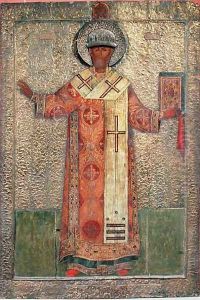Simon Ushakov Paintings
Simon Ushakov was a leading Russian graphic artist of the late 17th century who is particularly noted for his contributions to the development of Russian iconography. Born in Moscow in 1626, Ushakov became a prominent figure in the world of Russian art during a period of significant transformation. His work bridged the gap between the ancient traditions of icon painting and the burgeoning interest in secular and more realistic artistic representations that were emerging at the time.
In 1648, Ushakov was admitted to the Armoury Prikaz, the Kremlin workshop which was responsible for producing weapons, armor, and also engaged in various forms of artwork, including icon painting and book graphics. He quickly rose to become the head of the icon-painting workshop, and under his guidance, the Armoury Prikaz became a center for innovation in icon design.
Ushakov's style was distinctive, characterized by meticulous attention to detail, a fine sense of color, and an incorporation of Western artistic techniques, such as perspective, into traditional Russian iconography. He was also a teacher and a theorist; his written work 'The Message to an Art Lover' provided detailed explanations of the principles behind his art, reflecting his belief in the importance of both spiritual and aesthetic qualities in icons.
Among Ushakov's most famous works are 'The Last Supper' (1685) and the 'Saviour Not Made by Hands' (1658), which showcase his skill in combining the spiritual symbolism of traditional Russian iconography with a more nuanced, realistic approach to the human figure and facial expressions. His icons are often noted for their serene and compassionate depiction of biblical figures, and Ushakov is credited with creating a 'heavenly aesthetic' that had a lasting influence on Russian art.
Ushakov's innovative approach extended beyond his painting. He was involved in graphic design, contributing to the embellishment of books and manuscripts. His legacy continued to influence Russian art long after his death in 1686, as his students and followers carried on his artistic traditions, blending the spiritual with the increasingly popular secular art forms. Ushakov's work marked a turning point in Russian art, making him a key figure in the transition from medieval to modern Russian culture.
